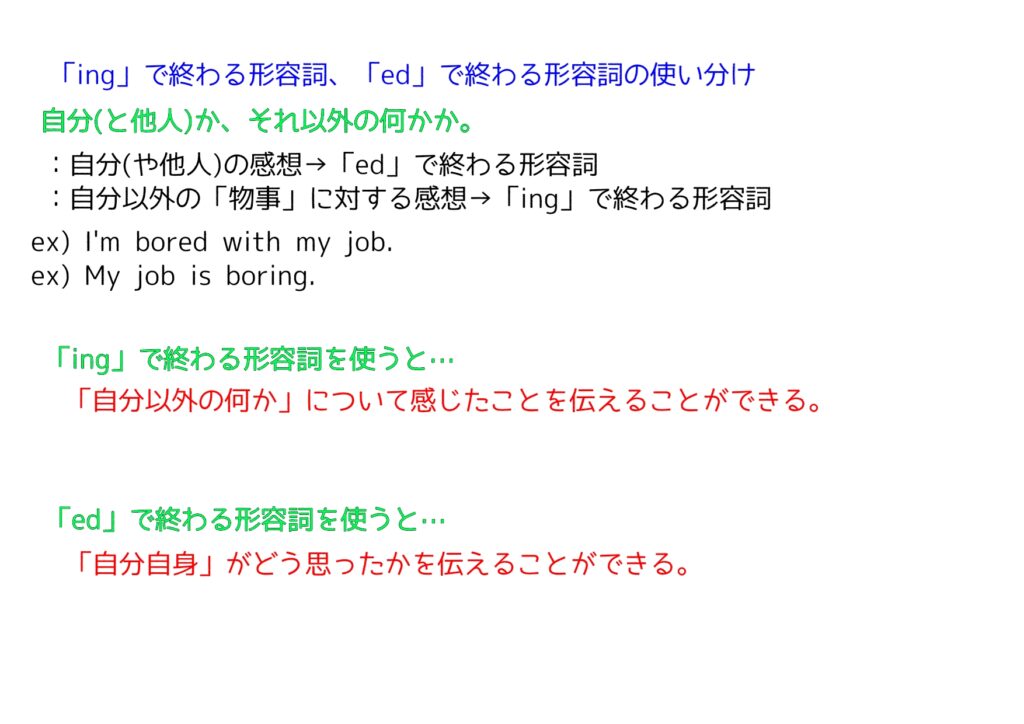第69回:分詞や複合語を形容詞の役割として使う。

どのような言葉遣いになるのかを見てみましょう。
Q. この記事で、一番大事なことって何?
A. 大事なことを、1枚の画像にまとめました。

いちいちノートにまとめるのが面倒だという方、また、
ノートにまとめることが苦手だという方は、ご活用ください。

[広告]
確かな英語力は、日々の継続から。
その継続を後押しする、第二言語習得理論に基づいた
オンライン英語学習プログラムがあります。
英語を使う人のための、確実なスキルアップが望める
7日間の無料体験はこちらから!

形容詞の役割を持つ様々な言葉
今回は、分詞形容詞と複合形容詞について解説します。これらの形容詞の使い方や特徴を見ていきましょう。
- 分詞形容詞(Participle Adjectives)
現在分詞の-ing形と過去分詞の-ed形の動詞は、形容詞として使用することができます。これらの分詞形容詞は、説明する名詞の前に置かれるか、または連結動詞の後に置かれます。同様に、”pleasing”(喜ばしい)や”delighted”(喜んでいる)などの分詞形容詞も使われます。
- 縮小形の関係節(Reduced Relatives)
多くの分詞形容詞は、名詞の後に直接置かれることもあります。この使い方は、定義的な関係節に似ており、「reduced relatives(縮小関係節)」と呼ばれることがあります。ただし、このような使い方はあまり一般的ではなく、あくまで特定の文脈で使用されます。
- 「that」と「those」の使用
形式的な英語では、「that」と「those」を分詞形容詞の前に代名詞として使用することがあります。
- 複合形容詞(Compound Adjectives)
多くの複合形容詞には、分詞形容詞が含まれています。一般的なパターンとしては、「副詞+過去分詞」や「副詞+現在分詞」があります。例えば、「well-behaved」(行儀の良い)や「fast-growing」(急速に成長している)などがあります。
また、「形容詞+過去分詞」や「形容詞+現在分詞」の組み合わせもあります。「She seems to live on ready-made meals.」(彼女はすぐに食べられる食事を食べるようです。)という文では、「ready-made」(即席の)という形容詞が使われています。
さらに、「名詞+過去分詞」や「名詞+現在分詞」の組み合わせもあります。「The public square was tree-lined.」(その広場には木が並んでいました。)
特に注意が必要なのは、これらの複合形容詞は単体で使用されることはなく、必ず副詞や名詞と組み合わせて使われる点です。
以上が、分詞形容詞と複合形容詞についての解説でした。これらの形容詞をうまく使いこなして、表現の幅を広げてみましょう。
具体例
participle adjectives used before the noun:
- The screaming child disrupted the concert.
- We saw a fallen tree blocking the road.
- She noticed the missing book on the shelf.
participle adjectives used after nouns in reduced relative clauses:
- The students’ essays, written in haste, lacked coherence.
- He shared his experiences, gained during his travels abroad.
- The challenges faced by the team, while daunting, were eventually overcome.
participle adjectives with “that” or “those” as pronouns:
- The results were better than those expected.
- The situation is worse than that predicted.
- The students, studying diligently, achieved excellent grades.
compound adjectives with adverb + -ed participle:
- He is a well-dressed gentleman.
- The newly-built house is modern and spacious.
- She is a highly-educated professional.
compound adjectives with adjective + -ing participle:
- It was a heartwarming story.
- The fast-growing city requires more infrastructure.
- The hardworking team completed the project on time.
compound adjectives with noun + -ed participle:
- We visited the art gallery with its beautifully-painted walls.
- The sunlit room provided a warm and cozy atmosphere.
- They explored the wildlife in the densely-populated forest.
compound adjectives with noun + -ing participle:
- She attended a mind-boggling magic show.
- The award-winning film received critical acclaim.
- We enjoyed a mouthwatering, home-cooked meal.
Note: These examples demonstrate the usage and patterns of participle adjectives and compound adjectives, but it’s important to note that not all compound adjectives include participle adjectives.
[広告]
TOEICのスコアを上げたいけれど、
まとまった勉強時間が取れなくて困っている…
なら、細かいスキマの時間を使いながら、
少しずつスキルを積み重ねてみてはどうでしょう。
スマホ1つでスコアアップが出来る、
オンライン講座のリンクはこちらから。

Q. この文法はどうやって使うのでしょうか?
A. 今回の文法を活用した会話文を見てみましょう。

Have you seen the new action movie?
(新しいアクション映画見た?)

Yes, I watched it last night. It was an adrenaline-pumping experience.
(うん、昨日観たよ。めちゃくちゃハラハラドキドキした体験だったよ。)

Really? I’ve heard that the special effects are mind-blowing.
(本当?特殊効果すごいって聞いたんだけど。)

Absolutely! The movie had state-of-the-art visuals and jaw-dropping stunts.
(そうなんだ!映画は最新の映像技術と驚くべきスタントがあったんだ。)

That sounds incredible. I’m looking forward to seeing it. Is it a box-office hit?
(それはすごいね。観るの楽しみだな。ヒットしてるの?)

Definitely! It’s been drawing in a large and captivated audience.
(もちろん!観客動員数がスゴイ映画だよ。)

I can’t wait to be part of that excited crowd.
(そのワクワクする観客の一員になれるのが待ちきれないよ。)
[広告]
ロゼッタストーン・ラーニングセンターで、最先端の教育制度を活用して英語を学びませんか?私たちは個々の学習ペースに合わせてeラーニングと対面教育を組み合わせ、柔軟な学習環境を提供しています。自宅でのeラーニングと対面教育のメリットを最大限に活かし、あなたの英語学習をサポートします。最新のテクノロジーと個別の指導が組み合わさった当センターで、自由な学習スタイルを体験してみませんか?英語学習を楽しく効果的に進めるための環境がここにあります。新たな一歩を踏み出して、新しい英語学習の旅に参加しましょう!

Q. この記事の要点は?
A. 分詞や複合語を形容詞として活用しました。
Participle Adjectives:
- Present participles (-ing forms) and past participles (-ed forms) of verbs can be used as adjectives.
- Participle adjectives can be used before the noun they describe or after linking verbs.
- Some participle adjectives can be used immediately after nouns, similar to defining relative clauses.
- In formal English, “that” and “those” can be used as pronouns before participle adjectives.
Compound Adjectives:
- Compound adjectives often include a participle adjective.
- Common patterns for compound adjectives are: adverb + participle, adjective + participle, noun + participle, participle + particle.
- Some participle adjectives can only be used in adjective compounds and require the adverb or noun for completeness.
- There are many compound adjectives that don’t include participle adjectives.
英会話を始めてみたいけれど、どのサービスが良いか分からない…
そんな方は、まず、この記事で3つのサービスを比べてみてはいかがでしょうか?
英語力を効率良く伸ばすことができるサービス3選です。

次回の文法解説は?
形容詞の後。不定詞だったり、that節だったり。
この記事を作る際に参考にした文法の解説書になります。
すべて英語で書かれていますが、練習問題が付いてます。
イギリス英語なので、スペル等の表記が異なる部分もありますが、
「使い方を練習したい」「繰り返し問題を解きたい」
という方は、使ってみても良いかもしれません。

関連記事一覧
[広告]
日本人の講師と学んで、英語を使う不安を減らし、
ネイティブの講師とのレッスンで、学んだことを活用する
そんな、体系的な英会話のレッスンを提供している、
オンライン英会話スクールのリンクはこちら。

他の文法解説記事を検索できます。



-320x180.jpg)

-320x180.jpg)

-320x180.jpg)

-320x180.jpg)
-320x180.jpg)




コメント